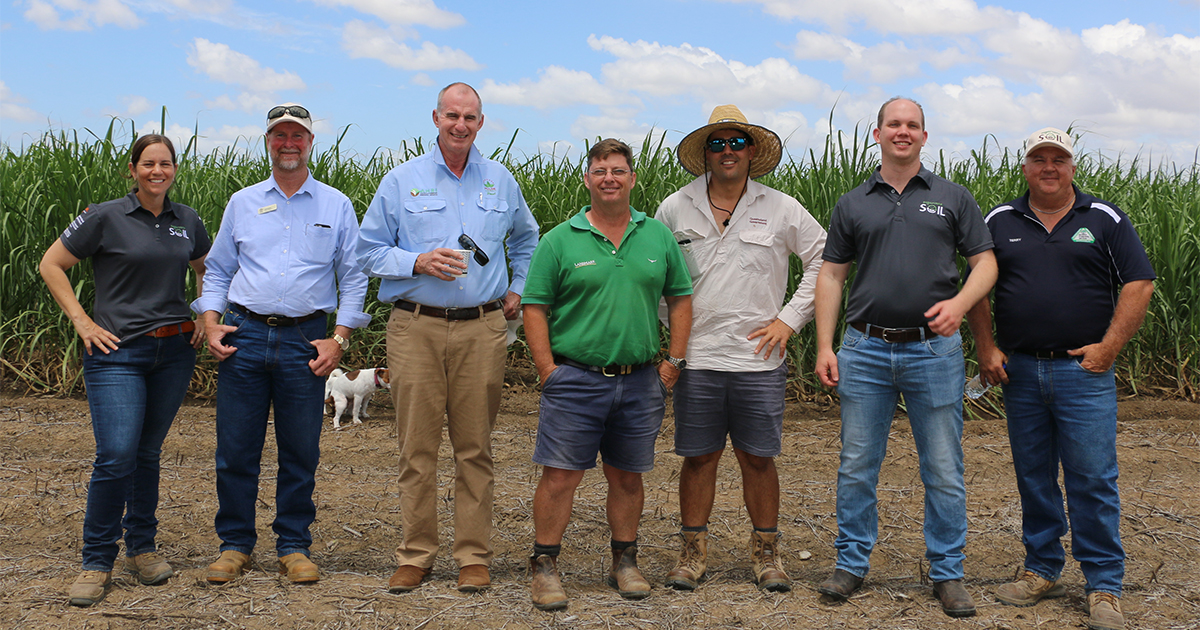Soil Health Officer Terry Granshaw discussing legume production with Burdekin grower Paul Villis.
Legumes improving soil health and farm profitability
by Sam Ryalls, SRA
Paul Villis, has been farming in the Burdekin since 2005, managing 400 ha for Jurgens Farming near the Kalamia Mill, including and 40 ha of his own land.
With a background in grain cropping, Paul had the advantage of looking at the sugarcane farming system with fresh eyes. And in doing so, he quickly identified the potential to improve the farming system and overall farm profitability.
One of the early steps was growing soy and mung beans between sugarcane crop cycles with the help of equipment borrowed from a neighbour. This allowed Paul to test legume break crops within the sugarcane farming system without substantial up-front capital investment.
The initial plan was to improve soil health – as Paul says, “cane is king” – but these legume break crops now make an important contribution to the farm’s bottom line, especially as varieties have improved and the Burdekin has developed mature marketing systems and agronomic support.
“The positive impact to the following cane crops, I feel there is no comparison, especially in the plant and first ratoon crops,” Paul said. “At the same time, I am a firm believer if you are going to go to the trouble of growing a break crop then you want to get some value from that crop. We can do that here in the Burdekin, but we also need to do it well, given the costs of growing a crop requiring irrigation.”
They have since purchased their own equipment, and soybeans and mungbeans are now a staple part of their farming system. These crops are grown either after an early plough-out of the final sugarcane crop, to enable the growth of two successive legume crops, or after a late plough-out to get one legume crop in before establishing the next sugarcane crop cycle.
“We try and take out half our fallow blocks early in the season, and half late so that it splits the workload at the end of the year.”
His main advice for growers getting into legumes, especially as a cash crop, was to seek good agronomic support.
“We have an agronomist with great experience in legumes in other regions, and they are really helpful with making sure we correctly time our pesticide applications to ensure we comply with maximum residue levels.
“With cane you have a bit of leeway with herbicide applications, but with mungbeans especially, you can miss the application window in a blink. Timing is key to a successful legume crop.”
Legumes are one of the key principles for productive and sustainable cane production as recommended by the Sugar Yield Decline Joint Venture, alongside controlled traffic, minimum tillage and green cane trash blanketing.
Paul and Jurgens Farming continue to improve their farming system with a view to improving soil health. They are harvesting crops green where they can, and have looked at different irrigation methods such as sub-surface drip and solid set sprinklers to get the water through the trash blanket. Through most of the Burdekin, furrow irrigation is most commonly practiced, as getting water to flow along the length of the furrow can be difficult with a thick trash blanket.
They have also moved to a strip tillage system and are looking at other ways of improving soil health.
In that vein, they have built their own sub-surface dunder applicator, use GPS guidance for most farming operations, have trialled compost, and changed to banded application of mill by-products.
“Because we are close to Kalamia Mill we utilise the mill by-products as they have great benefits to our soil as well.”
Soil health workshops
In late 2019, Burdekin growers had an opportunity to hear a range of perspectives on growing legumes in the sugarcane farming system at recent Legume Agronomy Workshops. At each of the four events the host growers shared their personal experience in growing legumes and the significant benefits to sugarcane productivity, soil health and longer-term business profitability. Paul Villis was one of our workshop host growers.
A series of short videos have been produced to share the host growers’ experiences growing legume crops in the Burdekin.
At the conclusion of each event Dr Danielle Skocaj, Soil Health Project leader, from SRA gave an update on the soil health project in the Burdekin and Herbert regions. Dr Skocaj’s project ‘Measuring soil health, setting benchmarks and supporting practice change in the sugar industry’ is verifying and demonstrating the impact of different farming systems upon soil health, productivity and profitability in the Herbert and Burdekin regions.
Based on event feedback, growers particularly enjoyed the presentations on legume agronomy, soil health benefits and other grower experiences. Growers commented that we can all learn a lot more from each other and that legume fallow crops have excellent potential for improving the sugarcane farming system and overall profitability.

Workshop presenters Danielle Skocaj (SRA), Neil Halpin (DAF), Paul McIntosh (Pulse Australia), Brent Wilson (Landmark), Brock Dembowski (DAF), Caleb Connolly (DAF), Terry Granshaw (BPS).
The SRA Soil Health Project of the Herbert and Burdekin regions is kindly supported by Herbert Cane Productivity Services Ltd, Burdekin Productivity Services, Department of Agriculture and Fisheries, Wilmar Sugar Australia, The University of Queensland and University of Southern Queensland.
Source: Summer 2019 Cane Connection article re-published with permission from SRA.
Read Pulse Check blog articles | Pulse Check Coastal facebook | Subscribe to the monthly newsletter

